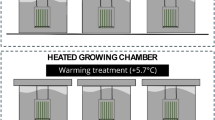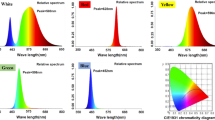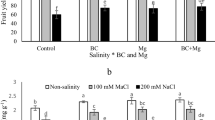Abstract
The effects of high NH4 + concentration on growth, morphology, NH4 + uptake and nutrient allocation of Myriophyllum brasiliense were investigated in hydroponic culture. The plants were grown under greenhouse conditions for 4 weeks using four levels of NH4 + concentration: 1, 5, 10 and 15 mM. M. brasiliense grew well with a relative growth rate of c.0.03 day−1 at NH4 + concentration up to 5 mM. At the higher NH4 + concentrations the growth of the plants was stunted and the plants had short roots and few new buds, especially when grown in 15 mM NH4 + where the submerged leaves were lost and there were rotten roots and submerged stems. To avoid NH4 + toxicity, the plants may have a mechanism to prevent cytoplasmic NH4 + accumulation in plant cells. The net uptake of NH4 + significantly decreased and the total N significantly increased in the plants treated with 10 and 15 mM NH4 +, respectively. The plant may employ NH4 + assimilation and extrusion as a mechanism to compensate for the high NH4 + concentrations. However, the plants may show nutrient deficiency symptoms, especially K deficiency symptoms, after they were exposed to NH4 + concentration higher than 10 mM. The present study provides a basic ecophysiology of M. brasiliense that it can grow in NH4 + enriched water up to concentrations as high as 5 mM.




Similar content being viewed by others
References
Barko JW, Smart RM (1981) Sediment-based nutrition of submersed macrophytes. Aquat Bot 10:339–352
Berg LJL, Dorland E, Vergeer P, Hart MAC, Bobbink R, Roelofs JGM (2005) Decline of acid-sensitive plant species in heathland can be attributed to ammonium toxicity in combination with low pH. New Phytol 166:551–564
Bristow JM, Whitcombe M (1971) The role of roots in the nutrition of aquatic vascular plants. Am J Bot 58:8–13
Britto DT, Kronzucker HJ (2002) NH4 + toxicity in higher plants: a critical review. J Plant Physiol 159:567–584
Britto DT, Siddiqi MY, Glass ADM, Kronzucker HJ (2001) Futile transmembrane NH4 + cycling: a cellular hypothesis to explain ammonium toxicity in plants. Proc Natl Acad Sci USA 98:4255–4258
Brix H, Dyhr-Jensen K, Lorenzen B (2002) Root-zone acidity and nitrogen source affects Typha latifolia L. growth and uptake kinetics of ammonium and nitrate. J Exp Bot 53:2441–2450
Bronmark C, Hansson LA (1998) The biology of lakes and ponds. Oxford University Press, Inc, New York
Cao T, Xie P, Ley N, Aiping W, Zhang M, Wu S (2007) The role of NH4 + toxicity in the decline of the submersed macrophyte Vallisneria natans. Mar Freshwater Res 58:581–587
Cao T, Xie P, Ni L, Zhang M, Xu J (2009a) Carbon and nitrogen metabolism of an eutrophication tolerative macrophyte, Potamogeton crispus, under NH4 + stress and low light availability. Environ Exp Bot 66:74–78
Cao T, Xie P, Li Z, Ni L (2009b) Physiological stress of high NH4 + concentration in water column on the submerged macrophyte Vallisneria natans L. Bull Environ Contam Toxicol 82:296–299
Carignan R, Kalff J (1982) Phosphorus release by submerged macrophytes: significance to epiphyton and phytoplankton. Limnol Oceanogr 27:419–427
Cedergreen N, Madsen TV (2002) Nitrogen uptake by the floating macrophyte Lemna minor. New Phytol 155:285–292
Chapman HD, Pratt PF (1978) Methods of analysis for soils, plants and waters. Division of Agricultureal Sciences. University of California, USA
Fang YY, Babourina O, Rengel Z, Yang XE, Pu PM (2007) Ammonium and nitrate uptake by the floating plant Landoltia punctata. Ann Bot 99:365–370
Goldyn H (2010) Changes in plant species diversity of aquatic ecosystems in the agricultural landscape in west Poland in the last 30 years. Biodivers Conserv 19:61–80
Hanlon EA, Gonzales JG, Bartos JM (1994) Soil testing laboratory chemical procedures and training manual. Circular 812, Institute Food and agricultural Science. University of Florida, Gainesville
Horne A, Goldman CR (1994) Limnology. McGraw-Hill, Inc, Singapore
Hussner A (2009) Growth and photosynthesis of four invasive aquatic plant species in Europe. Weed Res 49:506–515
Hussner A, Meyer C, Busch J (2009) The influence of water level and nutrient availability on growth and root system development of Myriophyllum aquaticum. Weed Res 49:73–80
Jampeetong A, Brix H (2009) Effects of NH4 + concentration on growth, morphology and NH4 + uptake kinetics of Salvinia natans. Ecol Eng 35:695–702
Kadono Y (2004) Alien aquatic plants naturalized in Japan: history and present status. Global Environ Res 8:163–169
Kitoh S, Shiomi N, Uheda E (1993) The growth and nitrogen fixation of Azolla filiculoides Lam. in polluted water. Aquat Bot 46:129–139
Lampert W, Sommer U (1997) Limnoecology. Oxford University Press, Inc, New York
Lictenthaler HK (1987) Cholophylls and carotenoids: pigments of photosynthetic biomembranes. Methods Enzymol 148:350–382
Litav M, Lehrer Y (1978) The effects of ammonium in water on Potamogeton lucens. Aquat Bot 5:127–138
Miller A, Cramer M (2005) Root nitrogen acquisition and assimilation. Plant Soil 274:1–36
Nelson, EN, Couch, RW (1985) History of the introduction and distribution of Myriophyllum aquaticum in North America. Proceeding, 1st International Symposium on Watermilfoil (Myriophyllum spicatum) and Related Haloragaceae Species, Vancouver, pp. 19–26
Oberholzer IG, Mafokoane DL, Hill MP (2007) The biology and laboratory host range of the weevil, Listronotus marginicollis (Hustache) (Coleoptera: Curculionidae), a natural enemy of the invasive aquatic weed, parrot’s feather, Myriophyllum aquaticum (Velloso) Verde (Haloragaceae). Afr Entomol 15:385–390
Smart RM, Barko JW (1985) Laboratory culture of submerged freshwater macrophytes on natural sediments. Aquat Bot 21:251–263
Smolders AJP, den Hartog C, van Gestel CBL, Roelofs JGM (1996) The effects of ammonium on growth, accumulation of free amino acids and nutritional status of young phosphorus deficient Stratiotes aloides plants. Aquat Bot 53:85–96
Smolders AJP, Van Riel MC, Roelofs JGM (2000) Accumulation of free amino acids as an early indication for physiological stress (nitrogen overload) due to elevated ammonium levels in vital Stratiotes aloides L. stands. Arch Hydrobiol 150:169–175
Sutton DL, Bingham SW (1973) Anatomy of emersed parrot feather. Hyacinth Contr J 11:49–54
Sytsma MD, Anderson LWJ (1993a) Biomass, nitrogen, and phosphorus allocation in parrot feather (Myriophyllum aquaticum). J Aquat Plant Manage 31:244–248
Sytsma MD, Anderson LWJ (1993b) Transpiration by an emergent macrophyte: source of water and implications for nutrient supply. Hydrobiol 271:97–108
Szczerba MW, Britto DT, Konstantine DB, Kronzucker HJ (2008) Alleviation of rapid, futile ammonium cycling at the plasma membrane by potassium reveals K+-sensitive components of NH4 + transport. J Exp Bot 59:303–313
Tylova E, Steinbachova L, Votrubova O, Lorenzen B, Brix H (2008) Different sensitivity of Phragmites australis and Glyceria maxima to high availability of ammonium-N. Aquat Bot 88:93–98
Tylova-Munzarova E, Lorenzen B, Brix H, Votrubova O (2005) The effects of NH4 + and NO3 − on growth, resource allocation and nitrogen uptake kinetics of Phragmites australis and Glyceria maxima. Aquat Bot 81:326–342
Wang MY, Glass ADM, Shaff JE, Kochian LV (1994) Ammonium uptake by rice root. Plant Physiol 104:899–906
Wang S, Jin X, Jiao L, Wu F (2009) Response in root morphology and nutrient contents of Myriophyllum spicatum to sediment type. Ecol Eng 35:1264–1270
Wang C, Zhang SH, Wang PF, Li W, Lu J (2010) Effects of ammonium on the antioxidative response in Hydrilla verticellata. Ecotoxicol Environ Safety 73:189–195
Xie Y, Luo W, Ren B, Li F (2007) Morphological and physiological responses to sediment type and light availability in roots of the submerged plant Myriophyllum spicatum. Ann Bot 100:1517–1523
Zhu B, Mayer CM, Rudstan LG, Mills EL, Ritchie ME (2008) A comparison of irradiance and phosphorus effects on the growth of three submerged macrophytes. Aquat Bot 88:358–362
Author information
Authors and Affiliations
Corresponding author
Rights and permissions
About this article
Cite this article
Saunkaew, P., Wangpakapattanawong, P. & Jampeetong, A. Growth, morphology, ammonium uptake and nutrient allocation of Myriophyllum brasiliense Cambess. under high NH4 + concentrations. Ecotoxicology 20, 2011–2018 (2011). https://doi.org/10.1007/s10646-011-0744-8
Accepted:
Published:
Issue Date:
DOI: https://doi.org/10.1007/s10646-011-0744-8




